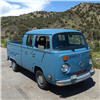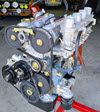| Author |
Message |
jtauxe 
Samba Member

Joined: September 30, 2004
Posts: 5971
Location: Los Alamos, New Mexico, USA

|
 Posted: Sat Nov 16, 2013 6:05 pm Post subject: two different axles Posted: Sat Nov 16, 2013 6:05 pm Post subject: two different axles |
 |
|
Today I disassembled the axles from the '75 single cab in order to rebuild/replace the CV joints. I was surprised to find that the two axles are of different types, and each has its own type of CV joint to match. I had only seen one type of axle before.
Here is a photo of the ends of the axles:
Note that the one on the left has coarse splines, the CV joint is held in place with two standard ring clips (one inner and one outer), and the location for the boot sleeve is closer to the end (though you can't see this in the photo). The axle seems to be generally of inferior quality, as the machining is rougher, too.
The one of the right, which I believe to be the genuine VW and is the only type I have seen before, has finer splines, uses only one special ring (of unique design) to contain the CV joint (the inner surface being a sort of "shoulder", and has the location for the boot sleeve further from the end.
Now - in addition to satisfying my curiosity, I have a quandary:
It turns out that on each axle, one of the CVs was toast (with galling on the bearing surfaces) and the other was serviceable, but not great (with wear, but no galling). So, I will be replacing one of each, if not all four.
I know that the Lobro CV joints will fit the axle on the right with the finer splines.
What do I do with the axle on the left? Are there CV joints available that fit it? Or do I have to bite the bullet and buy another fine-splined axle?
I'd be interested to know if anyone knows the provenance of the coarse-splined axle and if CV joints might be available for it.
_________________
John
"Travelling in a fried-out Kombi, on a hippie trail, head full of zombie..." - Colin Hay and Ron Strykert
http://vw.tauxe.net
1969 Transporter, 1971 Westfalia, 1976, 1977, 1976, 1977, 1971, 1973, 1977 Westfalias,
1979 Champagne Sunroof, 1974 Westfalia Automatic, 1979 Transporter, 1972 Sportsmobile, 1973 Transporter Wild Westerner, 1974 Westfalia parts bus, 1975 Mexican single cab *FOR SALE*, 1978 Irish 4-door double cab RHD
|
|
| Back to top |
|
 |
SGKent 
Samba Member

Joined: October 30, 2007
Posts: 42442
Location: at the beach

|
 Posted: Sat Nov 16, 2013 7:14 pm Post subject: Posted: Sat Nov 16, 2013 7:14 pm Post subject: |
 |
|
| does it have a manual trans? If so just buy a good set of used ones and use the best 4 CV's from your and that set. Most likely the aftermarket ones on the left won't work. I have read that automatics take different axles so if you have an automatic you need to compare notes with someone else who has one. All I've ever owner or serviced are manual trans buses. |
|
| Back to top |
|
 |
airschooled
Air-Schooled

Joined: April 04, 2012
Posts: 13474
Location: West Coast, USA

|
 Posted: Sat Nov 16, 2013 7:25 pm Post subject: Posted: Sat Nov 16, 2013 7:25 pm Post subject: |
 |
|
If that's the same Mexican-built truck you posted a while ago (which I envy…) then you might be in a bigger pickle than a few snap rings. Mexican mechanics are great at getting cars back on the road by any means necessary in record time.  Which can sometimes mean they use whatever parts are nearby. Which means sometimes you get funky combinations like this Which can sometimes mean they use whatever parts are nearby. Which means sometimes you get funky combinations like this 
_________________
One-on-one tech help for your vintage Volkswagen:
www.airschooled.com
https://www.patreon.com/airschooled |
|
| Back to top |
|
 |
jtauxe 
Samba Member

Joined: September 30, 2004
Posts: 5971
Location: Los Alamos, New Mexico, USA

|
 Posted: Sat Nov 16, 2013 8:25 pm Post subject: Posted: Sat Nov 16, 2013 8:25 pm Post subject: |
 |
|
Steve - Yes, it is a manual transaxle. That's all I have experience with, too, except for one automatic that did not need any CV work.
And yes, asaib, this is that Mexican Single Cab. But it never did (and in fact never could have, being a genuine German truck) served in Mexico proper.
I agree that past mechanics on this truck have played fast and loose with it. Examples about:
- Teflon tape holding in one of the carburetor jets
- Complete removal of the heating system, from the heat exchangers to the diffuser tree
- Mixing up the engine several times
In this case, all those previous owners (there were four) and all its mechanics lived in San Antonio. I know the last owner and the last mechanic who looked were either ignorant of what they had in their hands, or were deliberately shoddy in their work.
Given the abuse this poor truck has seen, I was not really that surprised to find what I found -- it was more of a reaction like, "Oh, another odd mismatched bit of crap, here..."
I suppose the best path forward is to ditch the crappy axle and buy a proper used VW one and fix that up.
With all the hidden problems with this single cab, I will have spent twice the original sales price in getting it on the road. And yet, it will still be worth it, 'cause it has such a cool backstory. In for a dime, in for a dollar...
_________________
John
"Travelling in a fried-out Kombi, on a hippie trail, head full of zombie..." - Colin Hay and Ron Strykert
http://vw.tauxe.net
1969 Transporter, 1971 Westfalia, 1976, 1977, 1976, 1977, 1971, 1973, 1977 Westfalias,
1979 Champagne Sunroof, 1974 Westfalia Automatic, 1979 Transporter, 1972 Sportsmobile, 1973 Transporter Wild Westerner, 1974 Westfalia parts bus, 1975 Mexican single cab *FOR SALE*, 1978 Irish 4-door double cab RHD
|
|
| Back to top |
|
 |
airschooled
Air-Schooled

Joined: April 04, 2012
Posts: 13474
Location: West Coast, USA

|
 Posted: Sat Nov 16, 2013 8:29 pm Post subject: Posted: Sat Nov 16, 2013 8:29 pm Post subject: |
 |
|
Glad to see you going at it full steam. I was originally worried about the substituted axle being a different size or "thread" for the splines. But if you just go for a new (old?) cvs/axle combo you won't have to worry about parts compatibility.
_________________
One-on-one tech help for your vintage Volkswagen:
www.airschooled.com
https://www.patreon.com/airschooled |
|
| Back to top |
|
 |
SGKent 
Samba Member

Joined: October 30, 2007
Posts: 42442
Location: at the beach

|
 Posted: Sat Nov 16, 2013 9:47 pm Post subject: Posted: Sat Nov 16, 2013 9:47 pm Post subject: |
 |
|
| jtauxe wrote: |
Steve - Yes, it is a manual transaxle. That's all I have experience with, too, except for one automatic that did not need any CV work.
And yes, asaib, this is that Mexican Single Cab. But it never did (and in fact never could have, being a genuine German truck) served in Mexico proper.
I agree that past mechanics on this truck have played fast and loose with it. Examples about:
- Teflon tape holding in one of the carburetor jets
- Complete removal of the heating system, from the heat exchangers to the diffuser tree
- Mixing up the engine several times
In this case, all those previous owners (there were four) and all its mechanics lived in San Antonio. I know the last owner and the last mechanic who looked were either ignorant of what they had in their hands, or were deliberately shoddy in their work.
Given the abuse this poor truck has seen, I was not really that surprised to find what I found -- it was more of a reaction like, "Oh, another odd mismatched bit of crap, here..."
I suppose the best path forward is to ditch the crappy axle and buy a proper used VW one and fix that up.
With all the hidden problems with this single cab, I will have spent twice the original sales price in getting it on the road. And yet, it will still be worth it, 'cause it has such a cool backstory. In for a dime, in for a dollar... |
John - most part buses end up with those tossed in the scrap heap. I would look for someone parting a bus and offer $20 plus shipping for a used pair of genuine VW ones. The actual axles last the life of the bus usually and the CV joints used are a crap shoot. Some VW wrecking yards will have thousands of them and ask like $100 a pair but they will NEVER sell a set at that. The metal is worth more than the used parts. If I had a set I'd send them to you for free. I used to keep the old ball bearings and replace the worn out ones for a few more rebuilds on the CV joints. Someone here should have a used pair laying in their back yard or garage they want to get rid of. |
|
| Back to top |
|
 |
jtauxe 
Samba Member

Joined: September 30, 2004
Posts: 5971
Location: Los Alamos, New Mexico, USA

|
 Posted: Sun Nov 17, 2013 2:19 pm Post subject: Posted: Sun Nov 17, 2013 2:19 pm Post subject: |
 |
|
Well, I am really more curious than anything.
Where did the coarse spline thing come from?
I presume it is some cheap aftermarket thing, where they save money on thicker (meaning fewer, meaning less time of the machinist, meaning cheaper to make) splines and rough machine work. The design of using two keeper rings also makes it cheaper to produce, because the machinist does not have to work with the "shoulder". And even the length of the axle from the end to the boot keeper, is shorter, scrunching up your boots. Even this I expect was made shorter in order to save money.
This is a great example of how to make a part cheaper. This vastly inferior produce is on the market because there are many people who will buy it instead of the real thing. Of course, it would be elitist of me to say that there is no place for more inexpensive parts. I can afford better parts at this point in my life, but when I started this obsession back in college, an outlay of hundreds of dollars for whatever part it needed was a daunting expense. But of course it was a much funner vehicle than the rusted out "Flintstone mobile" of a car that my first bus replaced.
I would purge the world of this crap part, but someone wants it, which means that there would ostensibly be CV joints that would fit it, then that's fine. Does anyone know of a source for these coarse-splined CVCs?
_________________
John
"Travelling in a fried-out Kombi, on a hippie trail, head full of zombie..." - Colin Hay and Ron Strykert
http://vw.tauxe.net
1969 Transporter, 1971 Westfalia, 1976, 1977, 1976, 1977, 1971, 1973, 1977 Westfalias,
1979 Champagne Sunroof, 1974 Westfalia Automatic, 1979 Transporter, 1972 Sportsmobile, 1973 Transporter Wild Westerner, 1974 Westfalia parts bus, 1975 Mexican single cab *FOR SALE*, 1978 Irish 4-door double cab RHD
|
|
| Back to top |
|
 |
|

